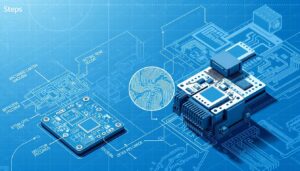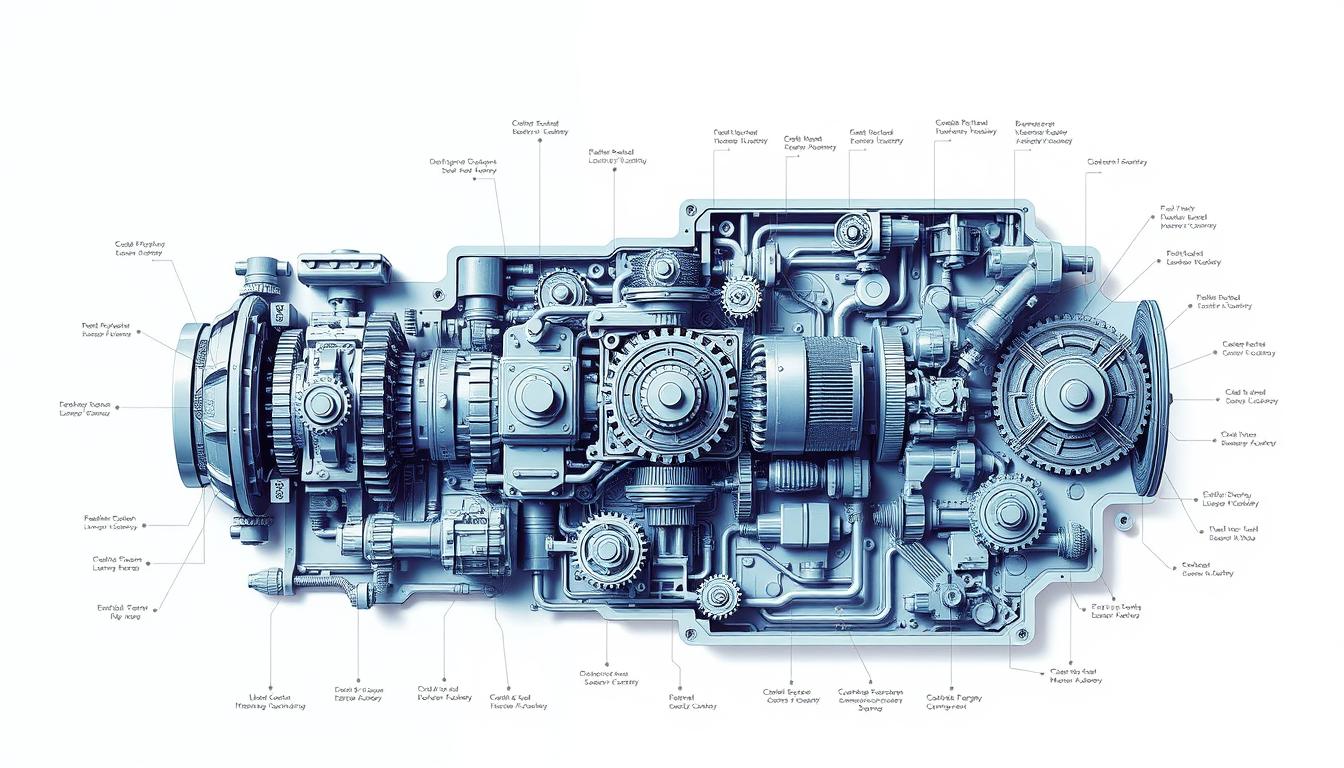سواء في الميكانيكاأو البرمجيات أو الأجهزة، تتيح الهندسة العكسية التحليل التفصيلي لبنية النظام ووظائفه. وهي تدعم قابلية التشغيل البيني من خلال الكشف عن البروتوكولات والتنسيقات غير الموثقة. يكتسب المهندسون رؤى لتحسين الأداء والأمان والتصميم. وهي تقود إلى أساليب جديدة تعتمد على التقنيات الحالية. وكثيرًا ما يُنظر إليها على أنها تكسير برمجيات، فهي تركز على الفهم والابتكار، وليس الاستغلال دائمًا.
تنصل: هذا المحتوى مخصص للتعليم تصميم المنتج الأغراض فقط ولا تشجع أو تؤيد الهندسة العكسية غير المصرح بها. في حين أننا نرى فوائدها للابتكار كما هو الحال بالنسبة لصيانة المنتجات القديمة والبيئة، فإن الهندسة العكسية قد تنتهك تراخيص البرمجيات أو شروط الخدمة أو الملكية الفكرية القوانين حسب الولاية القضائية التي تتبع لها. استشر دائمًا متخصصًا قانونيًا قبل الانخراط في أي أنشطة هندسة عكسية.
الهندسة العكسية في الإلكترونيات
تدور الهندسة العكسية في مجال الإلكترونيات حول تفكيك مزيج من العديد من المكونات الصغيرة، وتجميعها، بحيث يحتمل أن تكون برمجيات أو منطقية مدمجة لمعرفة كيفية عملها. وهو أمر أساسي في مجالات مثل السيارات والأدوات والآلات الكبيرة. في بعض الأحيان، يصعب العثور على التفاصيل المتعلقة بالتكنولوجيا أو تكون مغلقة. من خلال الهندسة العكسية، يمكن للمحترفين نسخ المشاريع التقنية أو تحسينها أو إصلاحها. فهم يتأكدون من أنها تلبي احتياجات وقواعد اليوم. تتعمق هذه المقالة في كيفية عمل الهندسة العكسية في مجال الإلكترونيات وخطواتها والأدوات التي يستخدمها الناس.
تطبيقات الهندسة العكسية في الإلكترونيات للهندسة العكسية الإلكترونية استخدامات عديدة في قطاعات مختلفة، مثل:
| أدوات الهندسة العكسية في الإلكترونيات تشمل الأدوات والأساليب الرئيسية ما يلي:
على الرغم من عدم رؤيته حتى الآن على نطاق صناعي، إلا أنه من المتوقع أن يغير التعرف الآلي على الرؤية والذكاء الاصطناعي هذا المجال قريباً. |
عملية إعادة الأجهزة

تتضمن عملية الهندسة العكسية العديد من الخطوات لإلقاء نظرة عميقة على الأجهزة الإلكترونية. تساعد كل مرحلة على فهم كامل للجهاز، مع التركيز على جميع الأجزاء المهمة:
- التقييم والملاحظة الأولية: تبدأ الهندسة العكسية بإلقاء نظرة فاحصة على الأجهزة، مع ملاحظة كيفية اتصال الأشياء وإعدادها. قد يتضمن ذلك النظر إلى الموصلات الكبيرة للواجهات المهمة. كما أنها تولي اهتمامًا للعلامات التي تعطي أدلة حول تصميم اللوحة واستخدامها. إن معرفة دوائر الطاقة والدوائر المتكاملة (ICs) وكيفية اتصالها أمر أساسي.
- تحديد مكونات الدائرة: بعد النظرة الأولى، يأتي تحديد كل جزء من أجزاء الدائرة بعد ذلك. يقوم المهندسون بتفكيك الجهاز وتسمية كل شيء. وهذا يساعدهم على فهم ما تفعله كل قطعة، مثل المقاومات والمكثفات والدوائر المتكاملة. من خلال تتبع هذه الأجزاء، يمكن للمهندسين تحليل الجهاز بشكل أفضل. وهذا يتيح لهم معرفة كيف يتناسب كل مكون مع النظام بأكمله.
- إنشاء المخططات: الخطوة الأخيرة هي عمل المخططات التي توضح تخطيط الدائرة. يستخدم المهندسون المعلومات التي حصلوا عليها من قبل لرسم مخططات تفصيلية. تجعل هذه المخططات عملية الهندسة العكسية واضحة، وتوضح كيفية اتصال الأجزاء وتفاعلها.
الهندسة العكسية في البرمجيات
الهندسة العكسية رائعة في العديد من المجالات، مما يدل على استخدامها على نطاق واسع. فهي كبيرة في مجال تحليل البرمجيات، حيث يكون الهدف هو فهم كيفية عمل التطبيقات الحالية. فمن خلال تفكيك البرمجيات، يتعرف الخبراء على كيفية عملها وسبب اختيار تصاميم معينة.
عند إصلاح الأخطاء، يلجأ المطورون إلى الهندسة العكسية. فهي تساعدهم في العثور على المشاكل في البرامج وحلها. وبهذه الطريقة، يمكنهم اكتشاف الأخطاء غير الواضحة بطرق التصحيح العادية. من خلال العثور على نقاط الضعف في التطبيقات الشهيرة، أو تقديم حوافز لذلك، يمكنهم بناء دفاعات أقوى لحماية معلومات المستخدم.
يرى مصممو الألعاب أيضًا فوائد في الهندسة العكسية. فهم يدرسون الألعاب الناجحة لمعرفة ما يحبه اللاعبون. ثم يضيفون تلك العناصر الشائعة إلى ألعابهم الخاصة لجعلها أكثر متعة.
أصبحت هذه الممارسة أكثر أهمية لتحليل البرمجيات. إنه أمر بالغ الأهمية لإصلاح المشاكل والتخطيط لاستراتيجيات جديدة. الهندسة العكسية هي تقنية أساسية في عالمنا الحديث الذي يشهد تغيرات تقنية سريعة.
الخطوات الرئيسية المتضمنة هناك العديد من الخطوات التي تشكل جزءاً من العملية:
| أدوات الهندسة العكسية للبرمجيات هناك عدة خطوات مهمة تشكل جزءاً من عملية الهندسة العكسية. وهي تشمل ما يلي:
|
التحليل الثابت مقابل التحليل الديناميكي

يستخدم المطورون وخبراء الأمن بشكل أساسي نوعين: التحليل الثابت والتحليل الديناميكي.
- التحليل الثابت يعني النظر إلى البرنامج دون تشغيله. يمكن للمحللين استعراض الشيفرة البرمجية واكتشاف نقاط الضعف والحصول على الصورة الكاملة للبرنامج. فهم يبحثون في التعليمات البرمجية أو الثنائيات لمعرفة كيفية عمل البرنامج. وبهذه الطريقة، يمكنهم العثور على المشكلات الخفية أو المخاطر الأمنية.
- من ناحية أخرى، يتعلق التحليل الديناميكي بتشغيل البرنامج لمعرفة كيفية عمله. فهو يتيح للخبراء رؤية تفاعل البرنامج مع البيئة المحيطة به، مع إظهار البيانات في الوقت الحقيقي، ومسارات التنفيذ، وإجراءات المستخدم. من خلال مشاهدة كيفية عمل البرنامج، يفهم المحللون كيفية عمله بشكل أفضل، مع ملاحظة كيفية استخدامه للذاكرة و...
لقد قرأت 41% من المقال. الباقي لمجتمعنا. هل أنت عضو بالفعل؟ تسجيل الدخول
(وأيضًا لحماية المحتوى الأصلي لدينا من روبوتات الكشط)
مجتمع الابتكار العالمي
تسجيل الدخول أو التسجيل (100% مجاناً)
اطلع على بقية هذه المقالة وجميع المحتويات والأدوات الخاصة بالأعضاء فقط.
فقط المهندسون والمصنعون والمصممون والمسوقون الحقيقيون المحترفون.
لا روبوت، ولا كاره، ولا مرسل رسائل غير مرغوب فيها.


























منشورات ذات صلة
التضليل البيئي: أفضل 15 نصيحة من رجل نبيل للخداع المتقن
كيفية التعامل مع براءة اختراع معلقة بأفضل طريقة
جميع حالات براءات الاختراع: معاهدة التعاون بشأن البراءات مقابل براءة اختراع قيد الانتظار مقابل براءة اختراع منشورة مقابل براءة اختراع ممنوحة
أفضل 10 استراتيجيات وأدوات لإبطال براءات الاختراع
تقييم دورة الحياة (LCA) في تصميم المنتج على وجه التحديد
نظرة عامة على تحليل قيمة المنتج